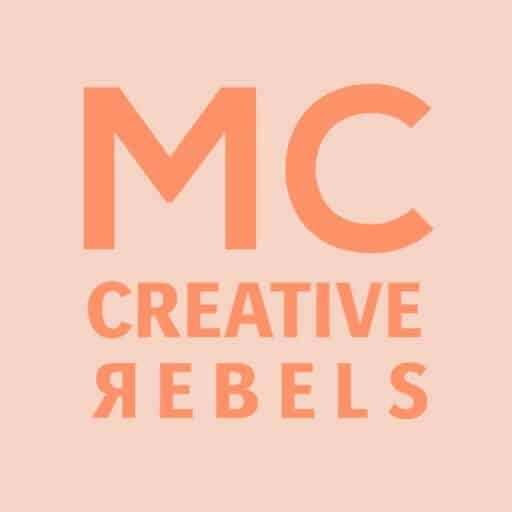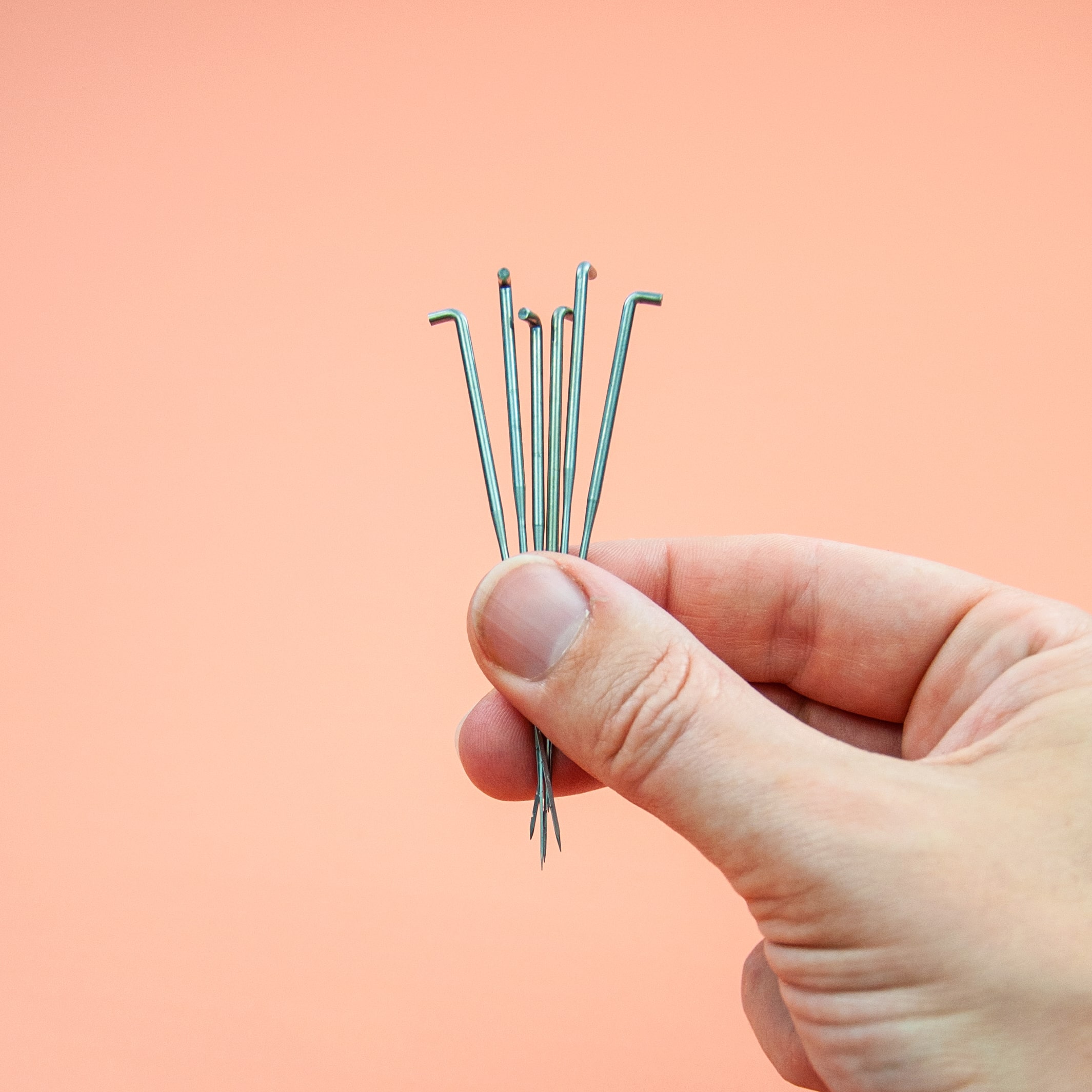Description
Buy multi-felting needles
Felting needles have a three-sided or four-sided (rigid) cross-section. Notches are made in the ribs of the sides. Behind these barbs, the hairs of the wool get stuck and are taken away. By moving back and forth you work the wool further and further together. That is felting the wool.
Prick, don't pry!
Attention: Felt needles are fragile. Make sure you always poke and pull the needle into the felt at the same angle. Avoid lateral tension, do not pry! It is wise to always have some extra needles in stock.
Overview types of felting needles
Felt needle 3-sided coarse (thickness 32 gauge) number 332
Universal needle for use with coarse to medium wool, intended for quick and global modeling of a basic shape.
Felt needle 3-sided fine (thickness 40 gauge) number 340
Universal needle for use with fine wool, intended for modelling details and also very suitable for applique work.
Felt needle 3-sided extra fine (thickness 43 gauge) number 343
For use with very fine wool, for applique work on fine fabrics such as silk and pricking very fine details.
Felt needle 4-sided fine (thickness 38 gauge star) number 438
For use with fine wool, ideal for evenly distributing fine wool, such as Merino wool on a basic shape that has already been felted with the coarse needle. A 4-sided needle has an extra barbed rib compared to a 3-sided needle, so it will felt faster. You will certainly notice the difference if you prick at an oblique angle, such as with superficial work.
Felt needle Reverse (thickness 32 gauge) number R32
With this needle, the barbs are applied in reverse. With that you pull the fibers out of the felt, as it were. For example, you can provide a needle-felted surface with an extra hairy surface and create a beautiful coat. Also useful for mixing different colors.
Felt needle Twisted (thickness 40 gauge) number T40
With this felting needle, the barbs are mounted on twisted ribs. As a result, you use the entire diameter of the needle, so not just three or four lanes as with a needle with straight ribs. As a result, this needle works more effectively and therefore faster.
Frequently asked questions about needle felting and multi-felting needles
1. What is needle felting and how do felting needles work? Needle felting is a craft in which special felting needles are used to intertwine and compress fibres, resulting in woven textiles; felt. Felt needles have notches along their shafts, which grip and push the fibres, allowing them to intertwine. Wool fibres, with their overlapping scales, lend themselves particularly well to this process.
2. How do I use felt needles to create three-dimensional shapes? To shape and compress wool in 3D, insert the felting needle in the desired direction. For example, to make a ball, insert from all directions and twist the wool evenly. You can also make cylinders or more complex shapes by joining simple shapes with extra wool.
3. What are the different types of felting needles and which should I use? There are different types of felting needles, including triangular, star and spiral shapes. The choice depends on personal preference and the task you are working on. Needle thicknesses, referred to as "gauge," range from coarse (e.g. 32-gauge) to fine (e.g. 43-gauge). Choose a higher gauge for detail work and a lower gauge for rough shaping or coarse fibres.
4. Should I use a single needle or a multi-needle holder? Using a needle holder with multiple needles is recommended to reduce the strain on your hand and arm. Squeezing a single needle between your fingers can be stressful, especially when needle felting repeatedly. It is essential to find a handle tool that fits comfortably in your hand.
5. How can I protect myself while needle felting? Using a handle tool for your felting needles is one way to protect your hand, wrist and arm. Make sure your workspace is well lit and ergonomically designed to work safely. Always handle felting needles with care to avoid accidents.
6. Why are different felt needle gauges important? Felting needles are available in different gauges, and each gauge has a specific purpose. Thicker gauges are suitable for coarse wool, while thinner gauges are better suited to fine wool. This is because coarse wool is microscopically thicker than fine wool, so a thicker gauge needle can make deeper notches to grip the fibres effectively. In contrast, a finer gauge needle does not work as well with coarse wool because the notches are not deep enough to grip the thicker fibres. Although you can use a thicker gauge needle for fine wool, the resulting holes will be more visible. Similarly, you can use a finer gauge needle for coarse wool, but this requires more poking to achieve the desired effect. This knowledge helps crafters choose the right needle for their specific project based on the texture and thickness of the wool.




Marjolein Touw (verified owner) –
Fine needles
Jannie van Assen –
It works fine
Inge Vos (verified owner) –
Everything is right
Klaasje Bouma-v.d.Leij (verified owner) –
Good felting needle.
Jose (verified owner) –
Works fine
Els (verified owner) –
The best felting needles!
Desiree Ubink (verified owner) –
meets my desire is not much to say about it seems to me
Judith van der Bliek (verified owner) –
Good quality
Judith van der Wart (verified owner) –
Nothing to comment on.
Luna Gallardo (verified owner) –
Works great
Lidwina Charpentier (verified owner) –
Trouble remains that the needles do not have the number on them. So if you have a few different ones you can nouw hardly tell which needle you have or you have to prick with it and even then. Difficult for my students.
Susanne (verified owner) –
The best I ever had!
J Van der Veen (verified owner) –
Excellent needles,convenient to use.
irene walker (verified owner) –
rather disappointed with needles , perhaps i mis translated the description but not what i really wanted
Sari De Haas (verified owner) –
fine needles
Marjan Wondergem (verified owner) –
Fine felting needles
Pytsje Cuperus (verified owner) –
Works well
Sophie Thomas (verified owner) –
Always good quality needles. The reverse needles pull the fibres out very well
Wendy Van Dijk (verified owner) –
Fine needles.
Sonja Shrub (verified owner) –
Works well
Lorenzo Garreyn (verified owner) –
Beautiful product!
Joke Voersma (verified owner) –
Good quality/price ratio
Janis Trops (verified owner) –
Looks good
Martina Nuzíková (verified owner) –
Completely satisfied.
Monique Smith (verified owner) –
Top product
Elke De Vidts (verified owner) –
great quality
Marjan (verified owner) –
Great product.
Lieke Dirk Sarrechia Aerts (verified owner) –
Fine needles
Rosemie De Brauwer (verified owner) –
does exactly what it needs to do
Christel Rans (verified owner) –
Prefer to work with it
Ann Vanmeerbeek (verified owner) –
Fortunately, you will find all kinds of needles for felting here! Rare…
Irma Brouwer (verified owner) –
good quality
cherished fosters (verified owner) –
All intact
Jet Reitsma (verified owner) –
Works well
Elisabeth Langrock (verified owner) –
Everything ok
Sybiel Smits Smits –
So many needles. A stock. Only downside is that the box doesn't close properly if you drop it. Read..pupils and 500 sharp needles on the ground.
Nelly CASSIMAN (verified owner) –
‘———-
viviane voormans (verified owner) –
My favorite for the finishing touch!
Marianne Goossens (verified owner) –
Good quality/price ratio. Needles can also be used in a Prym holder.